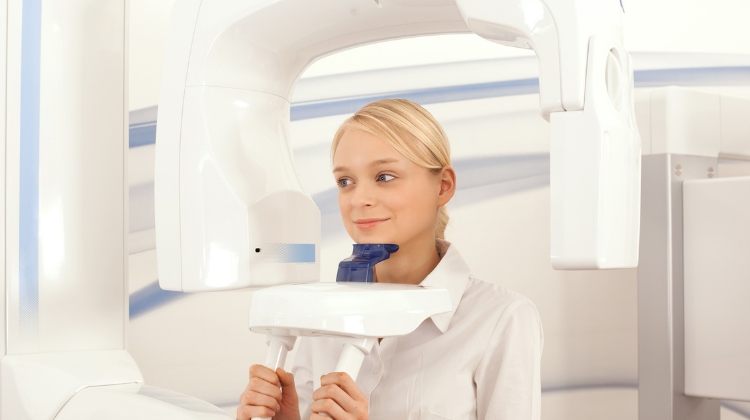Extraoral Dental X-ray Machine: Safety Requirements
%20(33).png)
Thanks to increased public discussion about radiation safety, patients today have greater concerns about their dentist using an extraoral dental X-ray machine than they did in the past. This is despite reassurance that a dental X-ray machine exposes them to far less radiation than other types of medical equipment such as a medical CT scan. As a dentist, it’s up to you to train your staff to reduce patient exposure to radiation and to educate patients about their actual risk.
How to Protect Patients When Taking Extraoral Dental X-rays or Cone Beam Images
Make sure you and your staff are familiar with your state’s regulations on patient protection during X-ray capture. Be sure all required radiation signs, posters, and stickers are posted and visible to patients.
Before positioning a patient in the X-ray machine, dental staff should place a leaded protective apron on the patient to ensure it covers his or her reproductive organs and thyroid glands during the scan. Most X-ray manufacturers recommend using an apron without a collar for panoramic X-rays, as the lead in the collar can interfere with most extraoral images during the scan around the patient’s head. These resultant images often have a white shark fin type shape in the center of the image, obstructing a complete view of the patient’s anterior dental anatomy.
Other ways of protecting your patients are common sense, but worth mentioning. If your panoramic or cone beam X-ray machine is installed in an area without a protective barrier, such as in a hallway, make sure that other patients or staff do not walk through this area while images are being taken. Also, be sure to ask patients if they have had recent extraoral X-rays taken at previous or referring dental providers, reducing the risk of unnecessary patient exposure. Be sure all patient monitoring devices, such as mirrors – and even baby monitors – are used to keep a watchful eye on obscured patients during image capture.
Plan Carefully to Avoid Retakes and Unnecessary Radiation Exposure
It can be frustrating for both the patient and the dental staff when it becomes necessary to take a repeat image due to a preventable mistake. To avoid having to take multiple images, ensure that you and your staff follow these steps:
- Help the patient get into the proper position and instruct him or her to remove all jewelry, including piercings
- Select exposure factors and other parameters appropriate for the patient and the situation
- Use the lowest possible settings to achieve the best results, applying the ALARA (as low as reasonably achievable) principle for radiation
- Ensure proper digital image processing and management
- Instruct the patient to remain as still as possible while staff captures the X-ray or cone beam scan
Staff Must Also Take Measures to Protect Themselves
Most states regulate radiation protection for dental practices and their staff. Make sure that your entire staff is aware of the dangers of radiation exposure, however minimal with extraoral X-ray machines. For example, the person using the dental X-ray machine should stand behind a protective barrier when capturing images. If none is available, the staff member should stand at a distance of at least six feet. Some states require the use of door interlocks and other safety devices to help secure the radiation area. Make sure you stay on top of all regulatory changes in your area so you can make any required modifications to the X-ray environment or workflow.
To help raise awareness of X-ray machine radiation safety, consider arming your dental team with radiation dosimeter badges. These badges measure the amount of radiation to which each member of your staff is exposed and the associated risks with each level. Check with your state regulatory authority – dosimeter badges may be required in yours.
Contact Us with Questions
We intend for the above to act only as a basic overview regarding the reduction of radiation exposure. You may contact Renew Digital with additional questions or for clarification at any time.


%20-%202023-05-23T092859.586.png)
